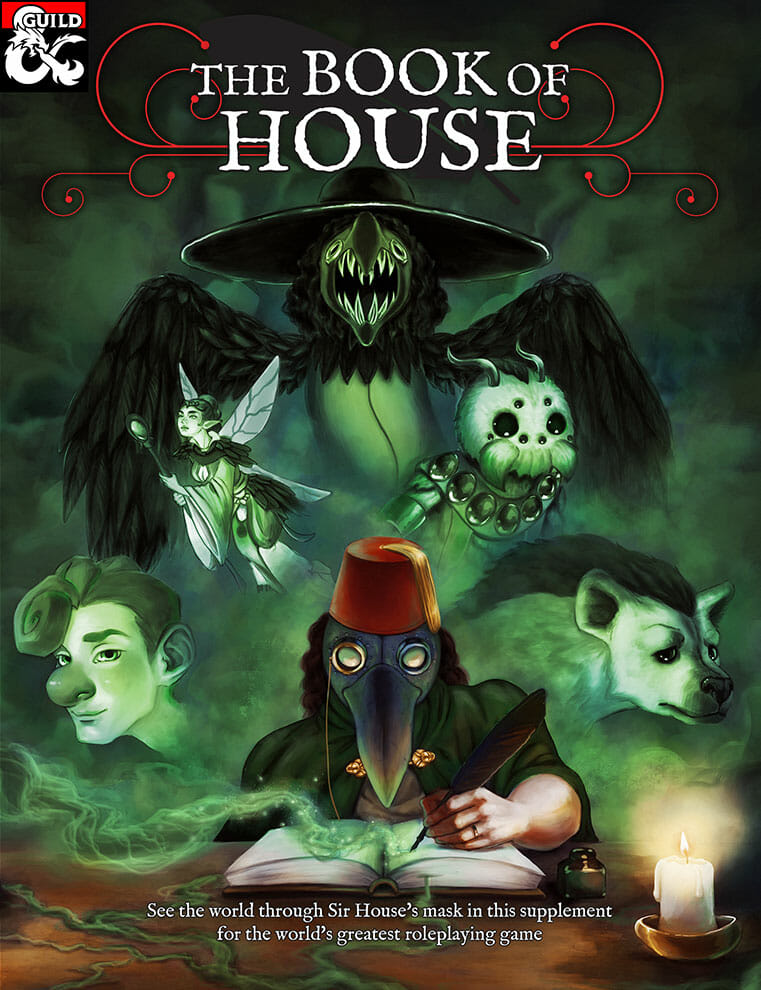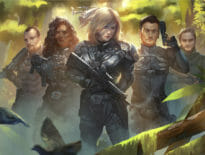There’s lots of 5e goodness packed into all 95 pages of The Book of House, but I suspect it’ll be remembered for the clowns. For the clonn, as they are known.
Geek Native was given a preview copy of the Book of House, but you can now buy it from the DMs Guild for $14.99.
If you only want the glimpse at the core rules for the Clonn race, then those are free. Grab them here, but you don’t get the Clonn feats, backgrounds and Clonn themed spells and magical items.
The Book of House reminds me of Xanathar’s Guide to Everything or Volo’s Guide to Monsters in that we have a personal tour of a fantasy world. In The Book of House, our guide is Sir House of Barovia of Barovia. He appears on page 5 of the book, wearing his Venetian style plague doctor mask, a fez and unicorn bunny slippers. I nearly stopped reading there. D&D, for me, isn’t a place for the whimsical and slapstick.
I’m glad I pressed on.
It’s not whimsy that The Book of House brings to D&D but a darker fairytale theme. If we’ve published a Genre Police essay in which we might find this supplement, then it would probably be the Brothers Grimm. The book, for example, does introduce stalwart sprites as a playable race and even gnolls battling against a curse of rage.
As it is the Book of House begins with the clowns and digs into the clonn as a race. It was the art that kept me scrolling. This supplement looks and feels like an official D&D product. If there did happen to be clowns in your village of 5e NPCs, then they would look like these clonns.
Early on, lead designer Willy Abeel describes the clonn as abnormal normal. They are, by the nature of being born a clonn, blithe and bulbous. There are some racial groups within the clonn, with the Pierronese having sharper faces, longer noses and chins and who emphasise technique and history, the other being the Bozolen who have plumper features and care more about empathy and crude humour. Both groups, though, would look right at home in a modern-day circus.

What I especially like is that the clonn fit into the typical fantasy world in terms of what they can do. You’ll no doubt know fantasy worlds were the fantasy races tend to embody one or two strong racial traits and humankind might first appear mundane but is the adaptable race from which geniuses on any subject can emerge. Not the clonn. The clonn tend to be skilful in anything they turn their hand to but that their aptitude ends there. Accomplished is as good as they get. They are the jack of all trades, the master of none.
Due diligence is given to bringing the clonn to life and helping you, as a player in a D&D game, create a tremendous clonn character. We’re given sample names, how clonn communities form and organise and even information on their celebrations. We’re provided clonn groups, religions and even emblems for clonn deities. Looking to fast track the arrival of clonns into the game and you are the DM? The Book of House has some notable clonns for you to use.
There’s both a quick and a detailed character build for the race. Later on, after we look at The Book of House’s other races, we’re given new feats and new backgrounds for PCs to use. Many of these new additions work exceptionally well (or exclusively) for the clonn. We also have new magical items and quite many new spells all of which feel fitting to that hinting at dark fairytale fantasy that I think the clonn might bring with them.
A beastly humanoid struggling to resist her racial curse towards anger and rage? Another dark fairytale? Sir House of Barovia of Barovia introduces us to the Tempered Gnolls.

These are another playable race but are not brought to life with the same level of detail as the clonns are. That’s not to say the detail on Tempered Gnolls is skimpy, just that there was significant effort on the clonn.
Gnolls were first created during the rampage of the demon lord Yennoughu and are born with a hunger for blood and carnage. The thing is, Gnolls rarely think alike, and sometimes, rarely, something gets in the way, and the Gnoll may begin to recognise an alternative to Yeenoghu’s plans for them. These are the Tempered Gnolls, and theirs is a dangerous state with regression a real danger for them.
Typical gnoll names? Typical gnolls don’t have names.
What the typical gnoll does have, thanks to their father Yeenoghu’s hatred of the demon lord Lolth, Queen of the Spiders, is a hatred of the spider race known as Tulas.
The Tulas are another of the playable races introduced by The book of House. If you don’t have coulrophobia and have read this far then let us hope you don’t have arachnophobia either because the Tulas are spiders.
These are spiders that stand toe-to-toe with halflings in terms of height (and have significantly more feet). It doesn’t feel right to classify these spiders as ‘small’, but that’s where they sit in D&D ruleset.
The Tulas do a much better job at ignoring the whispered urges and instructions of the demon lord responsible for their creation. They shrug Lolth’s dangerous suggestions off fairly easily except the urge to hunt gnolls is still very strong.

Sir House introduces us to a Tulas called Squish. While the clonn might be the standout race of the book, I suspect Squish will be (almost) everyone’s favourite character.
The last full race introduces in the book are Sprites. Now, as it happens, I’ve seen a wave of requests in Facebook groups from new D&D players wondering whether they can play garden fairies or pixies. Perhaps it’s the hint that spring might be approaching the northern hemisphere? The Sprites are indeed an answer to that request but as Sir House explains they are very different from the flightly pixies, and these fae are dedicated to protecting their home, are severe and stern.
We’re not quite done with new races though. Very much in the spirit of a Brothers Grimm fairytale, Sir House also wants to tell us about lycanthropic adventurers. This collection is a racial modifier and, a bit like the tempered gnolls, another group who must struggle against the dangers of feral regression.
There’s more than just the typical werewolf up for grabs. Here’s the full list;
- Wererat
- Wereraven
- Werewolf
- Wereboar
- Wheresquid
- Wereoctopus
- Weretiger
- Werewasp
- Wereshark
- Werebear
That’s right! Werewasp. That’s a new one on me. Terrifying. On the other hand; weresquids and wereoctopus are very different in appearance and make perfect sense to me. I think if you’re tempted by the new, now officially announced, Wizards of the Coast book Ghosts of Saltmarsh then The Book of House has a tempting set of lycanthropes for you!

I think it’s standard operating practice for new 5e supplements to introduce new magic and magic items. The Book of House does so. And, if I may suggest it, by keeping them closely fitting to the book’s new races they keep the tone and feel of these items broadly in line with the dark-ish fairytale. The same applies to new feats and backgrounds.
The new additions that don’t feel quite so Brothers Grimm to me are the subclasses. We’ve five of them. For the Bard, we have got the College of Culinary, essentially a cook or chef subclass. The Monk gives us the Way of the Caretaker and the Ranger provides the rather odd Mind Trapper. The rogue matches with the subclass Merchant who at level 17 can fuel a sneak attack with gold coins to ramp up the damage (1000 GP to turn the sneak attack to d20s). This ability feels more like Final Fantasy than a fairytale, I think, but its certainly in keeping with morality tales about sacrifice and betrayal. Lastly, the Sorcerer has the Residual subclass, which I rather like, as a character who has simply soaked up so much magic that they’re now magical.
All in all, Willy Abeel, Natalie Barillaro, Steve Barrett, Max Churak and Chris Diggins have surprised me and perhaps all of us with the Book of House. It feels like a contender. This purchase is a supplement that I can see DMs recommending to each other. I can see this download inspiring encounters and perhaps whole scenarios.
I accept that it might be hard to believe so here’s the YouTube channel The Home Brew Crew who agree with me. But I’m still not sure I’d let the players at it…
Geek Native was given a preview copy to look at ahead of publication at the DMs Guild.



